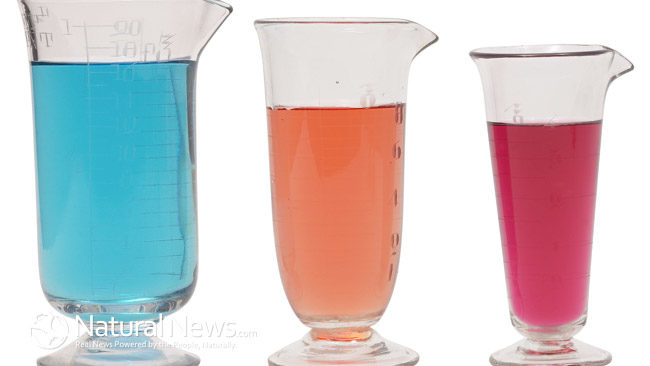I thoroughly enjoy researching the toxins “food scientests” produce, put into all processed food and how the FDA claims that they’re G.R.A.S. (Generally Recognized As Safe) With about 95% of the research I’ve done over the last two years the actual science, toxicity reports, manufacturing processes and pure technical aspect of it suggests otherwise.
When you see something that is “hazardous by definition”, toxic, poisonous or corrosive and it is in the food you’re eating you would have to stop, think and ask: “That’s going to go in me. Wait… It passes through the placental barrier? It decreases the testicular weight in mice? It’s produced with volvano ash? It’s processed with asbestos and krypton gas?”
I have to ask: If you know a food additive is toxic, corrosive or hazardous by definition, if it requires a flammable or corrosive DOT stickers while transporting, if it has saftey precautions and spill procedures and you must wear suitable protective clothing while handling… Can you even assume that it is safe to eat?
Irregardless of the exposure limits, the actual amount in food itself, how many regulations and standards there are or how low the toxicity may be… It is the general principle that it is still put in the foods you eat on a daily basis. I personally don’t believe when you drop a tomato you have to evacuate the area and seal off the exits. Because that is exactly the procedure for some of the chemcial agents allowed in your food.
General Research:
Aspartame
(cfr 172.804)
(N-L-alpha-Aspartyl-L-phenylalanine, 1-Methyl Ester)
Artificial Sweetener 200 times sweeter than sugar Aspartame is a synthetic chemical combination which is comprised of approximately
50% phenylalanine,
40% aspartic acid,
10% methanol
Aspartame has been approved in more than one hundred and thirty five countries.
The more aspartame within a blend, the better-tasting the product and the greater acceptance by consumers.
It is used in a wide range of prescription and over-the-counter medicines. In addition to analgesics, antibiotics, anti-inflammatories and nutritional supplements, powdered soft drinks, milkshake mixes, multivitamin preparations and semi-finished food products. Baked goods cereals. Fruit preserves, canned fruits, fruit preparations for the food industry.
There are now more than 6,000 products on the market sweetened with aspartame
In one test, consumers were asked to taste two isosweet samples of water. One sample was sweetened with aspartame, the other with sugar. When asked which sample was sweetened with sugar, 57% picked the sample actually sweetened with aspartame.
Nearly all diet sodas, gum and most candy (not chocolate – yet) are loaded with aspartame. Some chewing gum brands contain only synthetic sugars, which are acid creating. The body in turn creates fat cells to store that extra acid, and this is why many people who consistently eat Aspartame will ironically put on weight.
The EPA’s recommended limit of consumption of Methanol is 7.8 milligrams per day, but a one liter bottle of an Aspartame-sweetened beverage contains over 50 mg of methanol. Heavy users of Aspartame-containing products consume as much as 250 mg of methanol daily, which is over 30 times the EPA limit
Side affects: dizziness, headaches, behavioral changes, hallucinations, depression, nausea, numbness, muscle spasms, weight gain, rashes, fatigue, irritability, insomnia, vision problems, hearing loss, heart palpitations, breathing difficulties, anxiety attacks, slurred speech, loss of taste, tinnitus, vertigo, memory loss, and joint pain.
Also, many illnesses can be worsened by ingesting Aspartame, including chronic fatigue syndrome, brain tumors, epilepsy, Parkinson’s, Alzheimer’s, mental retardation, and especially diabetes.
Production of Aspartame
METHANOL
(The 10% in aspartame)
(Wood alcohol, Methyl alcohol; Methylol; Wood Spirit; Carbinol)
Hazardous in case of skin contact of eye contact of ingestion, of inhalation. Slightly hazardous in case of skin contact.
Severe over-exposure can result in death.
Mutagenic for mammalian somatic cells. Mutagenic for bacteria and/or yeast.
TERATOGENIC EFFECTS: Classified possible for human.
The substance is toxic to and causes damage to the eyes.
The substance may be toxic to blood, kidneys, liver, brain, peripheral nervous system, upper respiratory tract, skin, central nervous system (CNS), optic nerve.
Repeated or prolonged exposure to the substance can produce target organs damage.
Repeated exposure to a highly toxic material may produce general deterioration of health by an accumulation in one or many human organs.
May cause damage to the following organs: blood, kidneys, liver, brain, peripheral nervous system, upper respiratory tract, skin, central nervous system (CNS), optic nerve
Passes through the placental barrier. May affect genetic material.
May cause birth defects and adverse reproductive effects (paternal and maternal effects and fetotoxicity ) based on animal studies.
OSHA: Hazardous by definition of Hazard Communication Standard (29 CFR 1910.1200).
EINECS: This product is on the European Inventory of Existing Commercial Chemical Substances.
http://www.sciencelab.com/msds.php?msdsId=9927227
http://www.law.cornell.edu/cfr/text/21/172.804
http://www.google.com/url?sa=t&rct=j&q=&esrc=s&frm=1&source=web&cd=24&ved=0CD8QFjADOBQ&url=http%3A%2F%2Fwww.science.uva.nl%2Fresearch%2Famstel%2Fdws%2Fcontextchemie2%2Ffile.php%3Fid%3D2560&ei=WC9sUYy9JsGfiQKBj4HQAg&usg=AFQjCNEPBmpJPIkKUMUpZNE5n0mPJODAIw&sig2=4TUFnFvkIeWAcd8mSNlsrg : http://www.naturalnews.com/034320_aspartame_sweetener_side_effects.html#ixzz2OIfswqqZ
http://www.aji-aspartame.com/products/pdf/Ajinomoto_technical_booklet.pdf
http://leda.law.harvard.edu/leda/data/244/Nill,_Ashley_-_The_History_of_Aspartame.html





